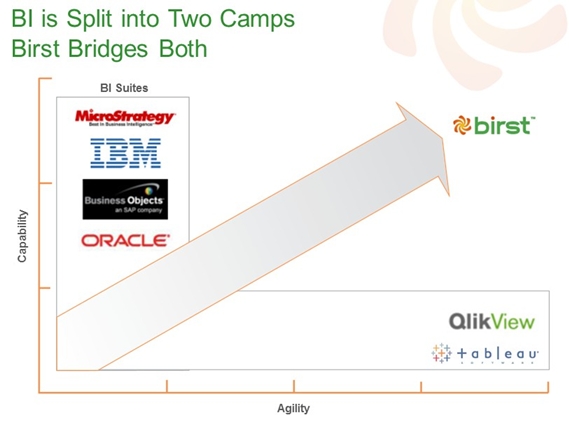Article first written for, and published as How Did We Get to Be So Analytical? Interview with Wynn White, VP of WW Marketing at Birst on Technorati.
Business Intelligence
Ten or so years ago, the guys who crunched numbers and charted data were easily identifiable by their thick-rimmed glasses and the space they inhabited back behind the lunchroom. A pack of CapriSuns and a box of Cheez-its were the only fuel necessary to take all sorts of disparate data sources and try to pull them together into a pie chart that could be loosely interpreted to drive business strategy. But over the past decade, things started shifting.
 Speaking with Wynn White, VP of Worldwide Marketing at Birst, I was navigated back through the historical points of this shift into the “consumerization of data” we are seeing today. “A driving force of all this was things like Google analytics,” explains Wynn, “People are using it every day.” Users who didn’t necessarily before, are able to access, and dive into information formerly reserved for data crunchers. We see evidence of this as the marketing discipline shifts into a stronger mix of creative and analytical.
Speaking with Wynn White, VP of Worldwide Marketing at Birst, I was navigated back through the historical points of this shift into the “consumerization of data” we are seeing today. “A driving force of all this was things like Google analytics,” explains Wynn, “People are using it every day.” Users who didn’t necessarily before, are able to access, and dive into information formerly reserved for data crunchers. We see evidence of this as the marketing discipline shifts into a stronger mix of creative and analytical.
The Need for More Insight
In a report commissioned by Birst and conducted by Dimensional Research, the company found that the number one 2012 priority for CIOs is business intelligence—making meaningful, actionable insight out of the mass of data points businesses now have. Wynn calls this, “The next wave of operational effectiveness.” He continues, “Big data has taken storm over the past 18 months. Massive amounts of unstructured data are being created, and at the same time we have this increased focus on analytics. The ‘old guard’ BI tools of the past were acquired by companies like IBM, and have somewhat stagnated.”
This study drives into light three main sentiments:
- Analytics provided by today’s Sales Force Automation (SFA) applications are inadequate
- Salesforce.com has not solved the business analytics problem
- Improved analytics capabilities are needed to extract full value from Salesforce.com
The takeaway being that Salesforce.com does not solve all of respondent’s business analytics questions. The solution, the study reveals, is well known for simplifying and streamlining SFA implementation, workflow, and customization. However, users of the product did not report any better experiences with the built-in business analytics in Salesforce.com, than they experienced with other products. In fact, only 20% of Salesforce.com users surveyed are “satisfied” or “very satisfied” with the analytics provided.
Two Camps of Business Analytics
What this all means is there’s a new requirement for usable, flexible data manipulation. And we’ve seen this, as some companies have introduced tools fully competent at enabling marketers and engineers alike to produce visual renderings of important information. But in looking at the industry, Birst finds the business intelligence camp is divided in two camps. As Wynn explains, “In one camp are highly capable offerings that are at the same time, super rigid [as to their output]. The other camp includes solutions focused on visual discovery.”

Agile Analytics for Business
Wynn says what Birst offers is a better way to make BI more usable. The solution is “fast based, with a lot of capabilities, all packaged up into a single offering,” he describes. Because it’s a single integrated solution, not only reporting, dashboards, backend for data management, Wynn continues, “We allow data to be ready for analysis. Giving a lot of the benefits of having a more contemporary benefits of BI.





One Reply to “How Did We Get to Be So Analytical? Interview with Wynn White of Birst”